သင့်အပလီကေးရှင်းအတွက် မှန်ကန်သော ဂျင်နရေတာရှာဖွေခြင်း၏ အရေးကြီးသောလုပ်ငန်းစဉ်မှတစ်ဆင့် နောက်ထပ်အကူအညီလိုအပ်ပါက ကျွန်ုပ်တို့ကို အီးမေးလ်ပို့ပါ သို့မဟုတ် 501049၊ 515036 တွင် ကျွန်ုပ်တို့ကိုခေါ်ဆိုပါ။
သဘာဝဘေးအန္တရာယ် သို့မဟုတ် စနစ်ပြဿနာကြောင့် ဓာတ်အားပြတ်တောက်မှုဖြစ်သည့်အခါ လက်ထဲတွင် မီးစက်တစ်ခုရှိခြင်းသည် ဘဝတစ်ခုလုံးကို ပိုမိုလွယ်ကူစေသည်။ ဆေးဘက်ဆိုင်ရာအကြောင်းပြချက်ကြောင့် လျှပ်စစ်မီးလိုအပ်သူများအတွက် အသက်ကယ်နိုင်သည်။ ခရီးဆောင်ဂျင်နရေတာသည် သင့်အိမ်တစ်ခုလုံးကို ပါဝါမပေးသော်လည်း ပါဝါပြန်လည်မရရှိမချင်း အသက်ခံနိုင်ရည်ရှိစေရန်နှင့် သက်တောင့်သက်သာဖြစ်စေရန်အတွက် လုံလောက်သောလျှပ်စစ်ဓာတ်အားကို ပေးစွမ်းနိုင်သည်။
အပိုင်း 1 (ဂျင်နရေတာတစ်ခုလည်ပတ်ခြင်း)
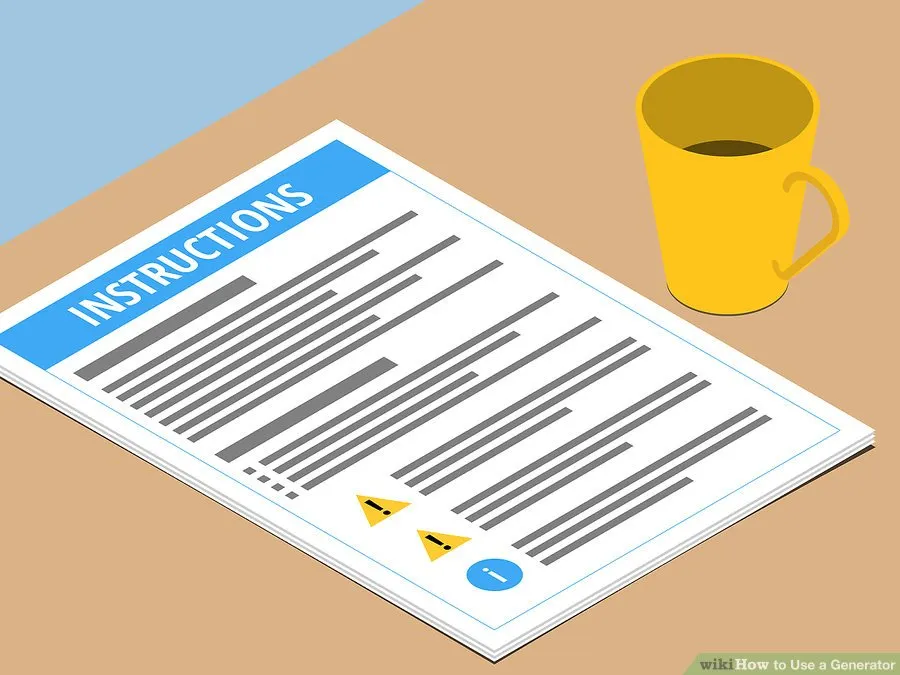
၁။ ထုတ်လုပ်သူရဲ့ ညွှန်ကြားချက်တွေကို ဖတ်ပါ။
အကယ်၍ သင်သည် သင်၏ ဂျင်နရေတာအား ယခင်က တစ်ခါမျှ အသုံးမပြုဖူးပါက သို့မဟုတ် ၎င်းကို အချိန်အတော်ကြာ အသုံးမပြုပါက၊ ဂျင်နရေတာမှ ပေးထားသည့် ညွှန်ကြားချက်များနှင့် ဘေးကင်းရေး အချက်အလက်အားလုံးကို ဖတ်ရန် အရေးကြီးပါသည်။ မီးစက်ကို စတင်ရန် မကြိုးစားမီ၊ စက်ကို ဘေးကင်းစွာ လည်ပတ်နည်းကို နားလည်နိုင်ရန် ထုတ်လုပ်သူမှ ပေးထားသည့် အချက်အလက်များကို ဖတ်ရန် မိနစ်အနည်းငယ် အချိန်ယူပါ။
- သင်လိုအပ်သည့်အခါ အမြန်ရှာဖွေရန် လွယ်ကူစေရန် ဂျင်နရေတာဖြင့် ဘေးကင်းရေးအချက်အလက်များကို သိမ်းဆည်းရန် စဉ်းစားပါ။
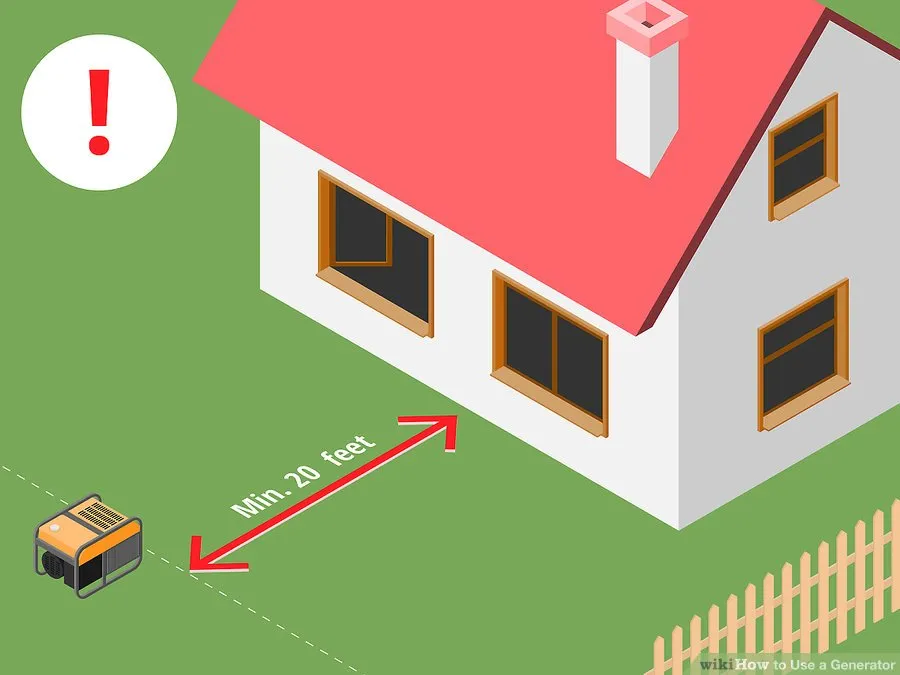
၂။ ဂျင်နရေတာအား သင့်လျော်သောနေရာတွင် သတ်မှတ်ပါ။
ဂျင်နရေတာများသည် ပူပြီး ဆူညံနိုင်ပြီး အန္တရာယ်ရှိသော မီးခိုးငွေ့များ ထွက်လာနိုင်သည်။ မီးစက်ကို အပြင်ဘက်၊ ခြောက်သွေ့သောနေရာတွင် ထားပါ၊ အခြားအရာများနှင့် အနည်းဆုံး ၃ ပေအကွာ၊ ဖွင့်ထားသော တံခါးများနှင့် ပြတင်းပေါက်များမှ အနည်းဆုံး ပေ ၂၀ အကွာတွင် ထားပါ။

၃။ လောင်စာဆီအဆင့်ကို စစ်ဆေးပါ။
သင့်ဂျင်နရေတာတွင် လောင်စာဆီတိုင်းကိရိယာတစ်မျိုးမျိုးရှိသင့်သည်။ စက်မစတင်မီ generator’s fuel tank ကို လုံလောက်စွာဖြည့်ထားကြောင်း သေချာပါစေ။ လိုအပ်ပါက သင့်လျော်သော လောင်စာဆီ များများထည့်ပါ။

၄။ ဂျင်နရေတာ၏ ဆီအဆင့်ကို စစ်ဆေးပါ။
ဂျင်နရေတာများသည် ၎င်းတို့၏ လည်ပတ်နေသော အစိတ်အပိုင်းများကို ချောဆီပေးရန် ဆီလိုအပ်သည်။ သင်၏ generator’s ထုတ်လုပ်သူ၏ ညွှန်ကြားချက်များကို လိုက်နာပြီး ၎င်းကို မစတင်မီ သင့်ဂျင်နရေတာ၏ ဆီအဆင့်ကို စစ်ဆေးပါ။ လိုအပ်ပါက ဆီထပ်ထည့်ပါ (ထုတ်လုပ်သူမှ သတ်မှတ်ထားသော အမျိုးအစားကိုသာ အသုံးပြုပါ)။
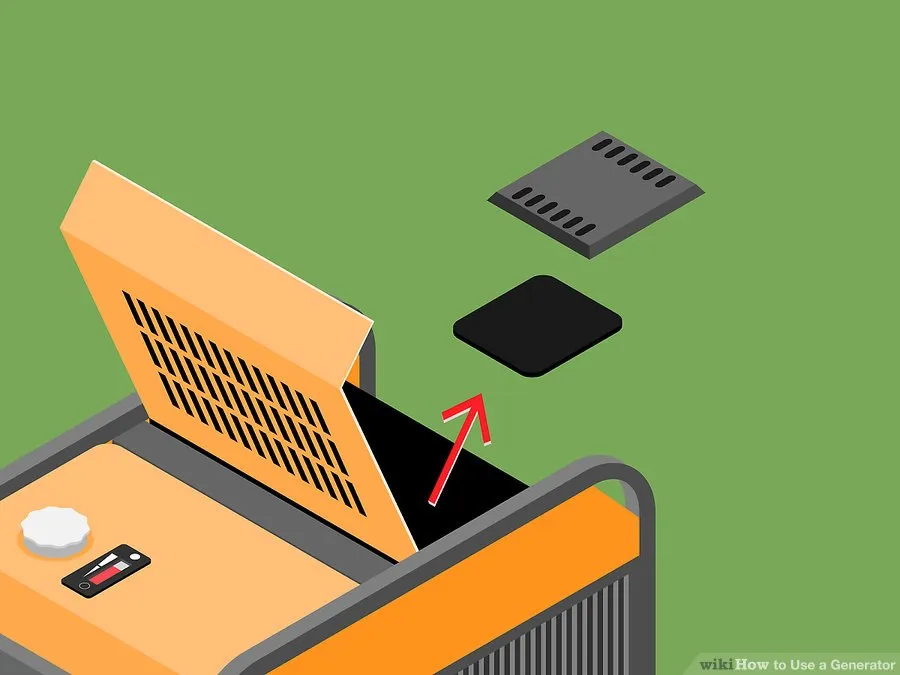
၅။ generator’s air filter ကိုစစ်ဆေးပါ။
သင်၏ ခရီးဆောင် ဂျင်နရေတာသည် ပါဝါထုတ်လုပ်ရန် လုပ်ဆောင်သည့် လောင်ကျွမ်းမှု လုပ်ငန်းစဉ်၏ တစ်စိတ်တစ်ပိုင်းအဖြစ် လေထဲတွင် နေရာယူသည်။ ဂျင်နရေတာမှဝင်သောလေသည် သန့်ရှင်းကြောင်းသေချာစေရန် ဇကာသည် အညစ်အကြေးများနှင့် အပျက်အစီးများကို ထောင်ချောက်ဆင်ထားသည်။ ဂျင်နရေတာမစတင်မီ စစ်ထုတ်မှုကို စစ်ဆေးရပါမည်။ ညစ်ပတ်နေပါက သို့မဟုတ် ပိတ်ဆို့နေပါက ထုတ်လုပ်သူ၏ ညွှန်ကြားချက်အရ သန့်ရှင်းရေး သို့မဟုတ် အစားထိုးပါ။

၆။ circuit breaker ကိုပိတ်ပါ။
သင့်ဂျင်နရေတာတွင် ပါဝါထုတ်သည့်အခါ ထိန်းချုပ်သည့်ခလုတ်တစ်ခုရှိပါမည်။ ဂျင်နရေတာမစတင်မီ ၎င်းသည် “OFF” အနေအထားတွင် ဘေးကင်းစွာ ရှိနေကြောင်း သေချာပါစေ။

၇။ လောင်စာအဆို့ရှင်ကိုဖွင့်ပါ။
ဤထိန်းချုပ်မှုသည် generator’s အင်ဂျင်သို့ လောင်စာဆီ စီးဆင်းသည့်အခါ ဆုံးဖြတ်သည်။ ဂျင်နရေတာသည် လည်ပတ်ရန်နှင့် ပါဝါထုတ်လုပ်ရန်အတွက် လောင်စာလိုအပ်သော်လည်း ဂျင်နရေတာစတင်ရန် အဆင်သင့်မဖြစ်မီအထိ လောင်စာအဆို့ရှင်ကို မလှန်သင့်ပါ။
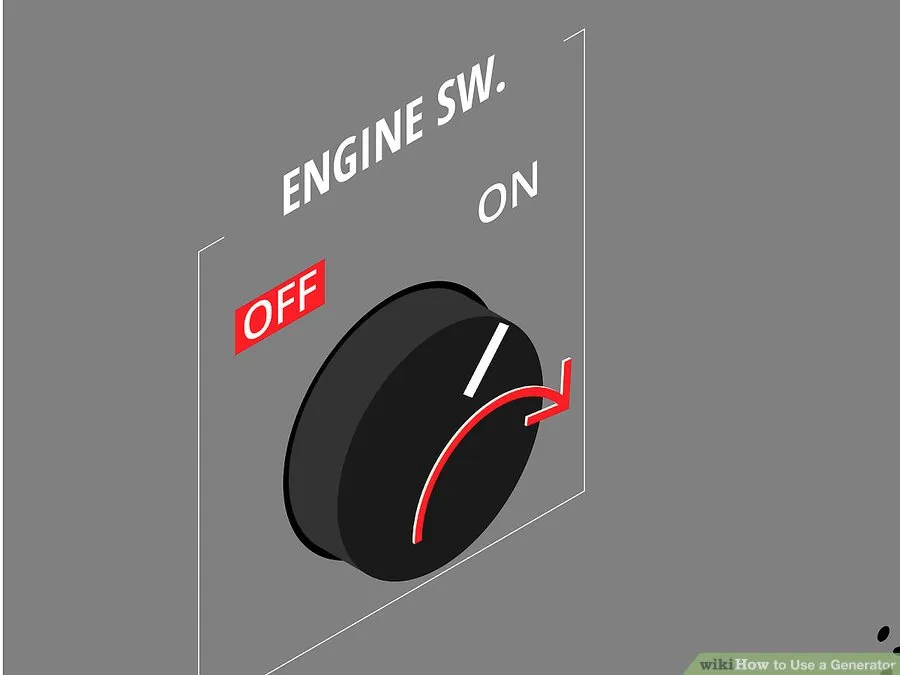
၈။ မီးစက်ကိုစတင်ပါ။
သင်၏ generator’s “START” ခလုတ် သို့မဟုတ် သော့ကို အသုံးပြု၍ စက်ကို ပါဝါဖွင့်ပါ။ circuit breaker ကို “ON” အနေအထားသို့ မပြောင်းမီ မိနစ်အတော်ကြာ မီးစက်ကို ပူနွေးစေပြီး လည်ပတ်စေသင့်သည် (မည်မျှကြာကြာ ပူနွေးသင့်သည်ကို အတိအကျသိရန် သင့်ဂျင်နရေတာ၏ ညွှန်ကြားချက်များကို စစ်ဆေးပါ)။
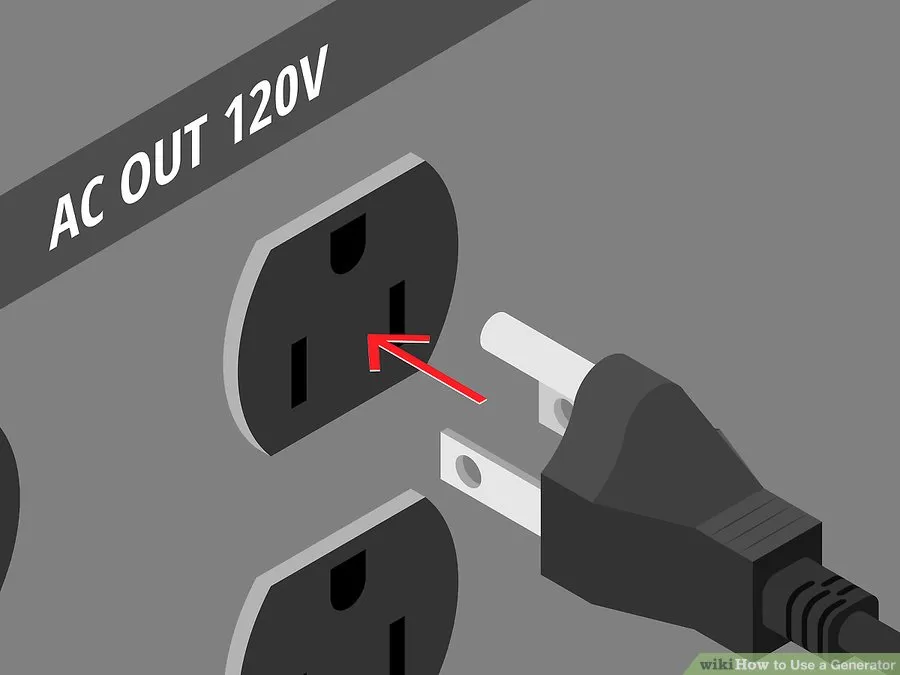
၉။ သင့်စက်ပစ္စည်းများကို ချိတ်ဆက်ပါ။
ဂျင်နရေတာများစွာသည် သင့်အား အီလက်ထရွန်းနစ်ပစ္စည်းများကို ဂျင်နရေတာထဲသို့ တိုက်ရိုက်ပလပ်ထိုးနိုင်စေပါသည်။ အတည်ပြုထားသော တိုးချဲ့ကြိုးကိုလည်း သင်အသုံးပြုနိုင်ပါသည်။ လေးလံသောတာဝန်၊ ပြင်ပအဆင့်သတ်မှတ်ထားပြီး မြေစိုက်ပင်ပါရှိသောတစ်ခုကို ရွေးချယ်ပါ။

၁၀။ မီးစက်ကိုပိတ်ပါ။
generator’s power မလိုအပ်တော့တဲ့အခါ ဒါမှမဟုတ် generator ကို ဆီဖြည့်ဖို့ လိုအပ်တဲ့အခါ စက်ကို ပိတ်သင့်ပါတယ်။ ပထမဦးစွာ circuit breaker ကို “OFF” အနေအထားသို့ ပြောင်းပါ။ ထို့နောက် generator’s power switch သို့မဟုတ် key ကို အသုံးပြု၍ စက်ကိုပိတ်ပါ။ နောက်ဆုံးတွင်၊ generator’s fuel valve ကို “OFF” အနေအထားသို့ သတ်မှတ်ပါ။

၁၁။ သင့်လိုအပ်ချက်အတွက် လုံလောက်သော လောင်စာဆီ ထောက်ပံ့မှုကို ထားရှိပါ။
သင်သိုလှောင်နိုင်သော လောင်စာပမာဏကို ဥပဒေများ၊ စည်းမျဉ်းများ၊ ဘေးကင်းရေးဆိုင်ရာ ထည့်သွင်းစဉ်းစားမှုများနှင့် သိုလှောင်ရန်နေရာတို့ဖြင့် ကန့်သတ်ထားနိုင်သည်။ ဂျင်နရေတာအား လိုအပ်သရွေ့ ပါဝါအလုံအလောက်ထားရှိရန် ကြိုးစားပါ။
- သင့်ဂျင်နရေတာသည် လောင်စာဆီတိုင်ကီတစ်ခုစီတွင် မည်မျှကြာကြာလည်ပတ်မည်ကို အကြံပြုချက်များအတွက် ထုတ်လုပ်သူ၏ ညွှန်ကြားချက်များကို စစ်ဆေးပါ။ ၎င်းသည် သင့်အား လက်ထဲတွင် လောင်စာဆီမည်မျှ ထားရှိရမည်ကို သိရှိစေနိုင်သည်။
- generator’s ထုတ်လုပ်သူမှ အကြံပြုထားသော လောင်စာအမျိုးအစားကိုသာ အသုံးပြုပါ။ မသင့်လျော်သောလောင်စာကိုအသုံးပြုခြင်းသည် အန္တရာယ်ရှိနိုင်ပြီး ဂျင်နရေတာ၏အာမခံချက်ကို ပျက်ပြယ်စေနိုင်သည်။
- သယ်ဆောင်ရလွယ်ကူသော မီးစက်များအတွက် အသုံးပြုလေ့ရှိသော လောင်စာများမှာ ဓာတ်ဆီနှင့် ရေနံဆီတို့ ဖြစ်သည်။
၁၂။ မီးစက်ကို ပိတ်ပြီး ဆီမဖြည့်ခင် အအေးခံထားပါ။
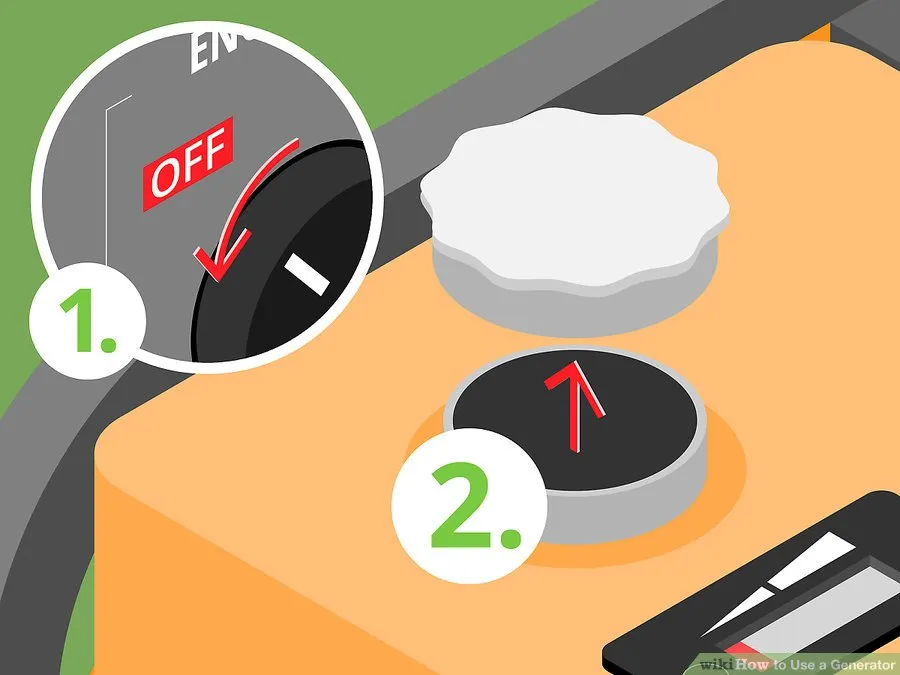
သင်အလိုအပ်ဆုံးအချိန်တွင် သင့်ပါဝါအရင်းအမြစ်ကို ပိတ်ရန် အဆင်မပြေနိုင်သော်လည်း ပူသောဂျင်နရေတာအား ဆီဖြည့်ရန်ကြိုးစားခြင်းသည် အန္တရာယ်ရှိနိုင်သည်။ စက်ကိုပိတ်ပြီး ဆီဖြည့်ရန် 15 မိနစ်စောင့်ပါ။ သင့်မိသားစု အိပ်ပျော်နေချိန်ကဲ့သို့သော အထွတ်အထိပ်အချိန်၌ မီးစက်၏ ဆီဖြည့်ရန် အချိန်ဇယားဆွဲခြင်းဖြင့် အဆင်မပြေမှုကို လျှော့ချနိုင်သည်။
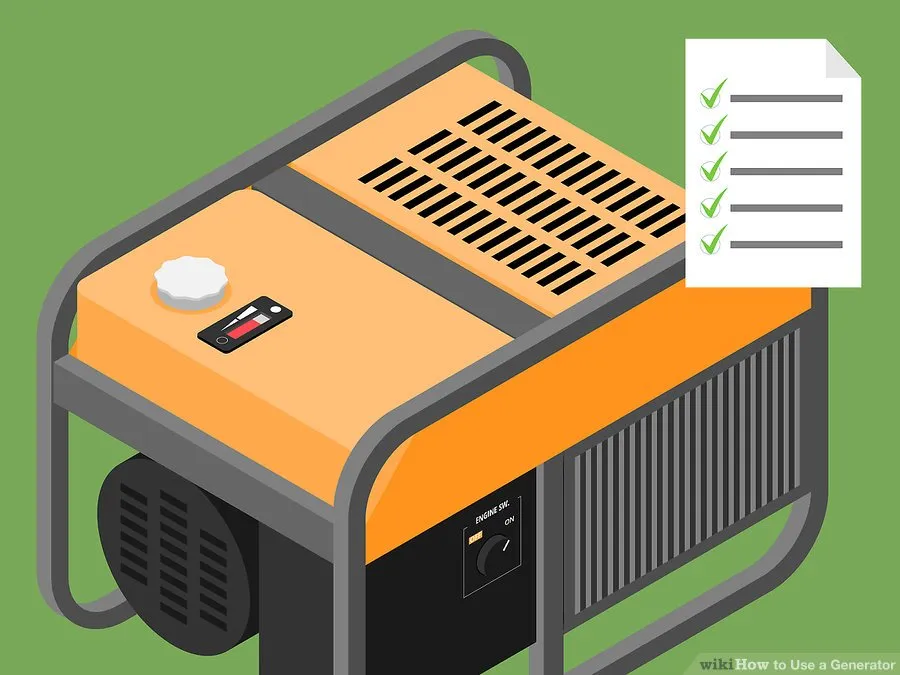
၁၃။ သင့်မီးစက်ကို ပုံမှန်စစ်ဆေးပါ။
သင့်ဂျင်နရေတာ ကောင်းမွန်စွာ အလုပ်လုပ်နိုင်စေရန် အရေးကြီးပါသည်။ ၎င်းကို အချိန်အကြာကြီး အသုံးမပြုနိုင်သောကြောင့် ပုံမှန်စစ်ဆေးမှုများ (တစ်နှစ်လျှင် အနည်းဆုံးတစ်ကြိမ်) စီစဉ်သင့်သည်။ အစိတ်အပိုင်းအားလုံးကို သန့်ရှင်းပြီး တိုင်ကီထဲတွင် လတ်ဆတ်သော လောင်စာများ ရှိနေကြောင်း သေချာပါစေ။
- ထုတ်လုပ်သူရဲ့ ညွှန်ကြားချက်အတိုင်း မီးစက်ကို သိမ်းဆည်းပါ။
- အရာအားလုံး ကောင်းမွန်စွာ အလုပ်လုပ်ကြောင်း သေချာစေရန် ဂျင်နရေတာအား တစ်လလျှင် တစ်ကြိမ်ခန့် အချိန်တိုအတွင်း လုပ်ဆောင်ပြီး စက်၏ အစိတ်အပိုင်းများ ချောဆီရှိနေစေရန်။
အပိုင်း 2- ဘေးကင်းရေး အကြံပြုချက်များကို လိုက်နာခြင်း
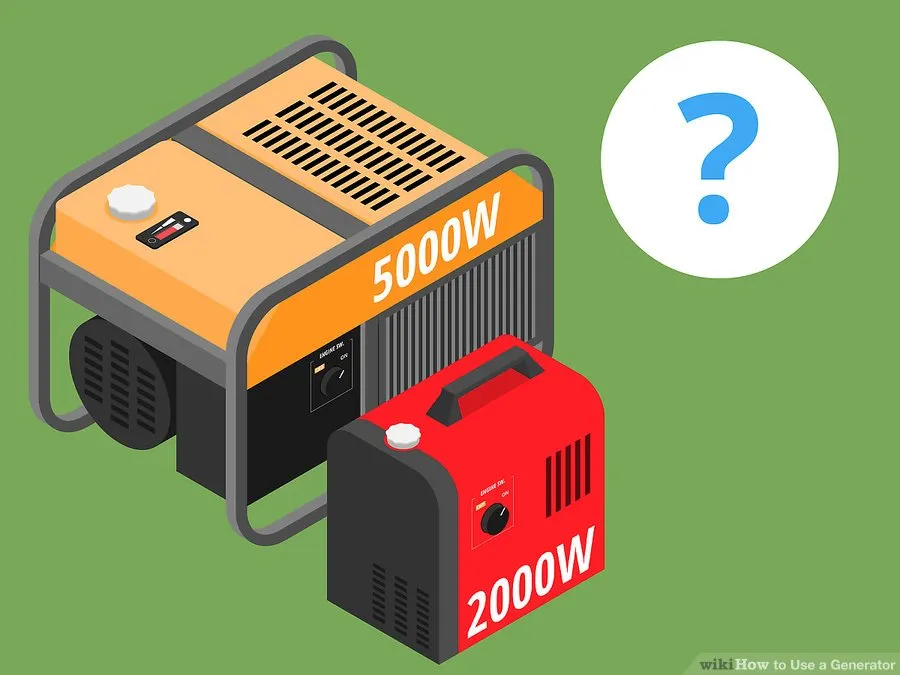
၁။ မှန်ကန်သော မီးစက်ကို ဝယ်ပါ။
ဂျင်နရေတာတစ်လုံးဝယ်နေတယ်ဆိုရင် သင်လိုအပ်မယ့် ပါဝါပမာဏကို ပေးစွမ်းမယ့် ပစ္စည်းတစ်ခုကို ရယူလိုက်ပါ။ ထုတ်လုပ်သူမှပေးသော အညွှန်းများနှင့် အခြားအချက်အလက်များသည် ၎င်းကိုဆုံးဖြတ်ရန် ကူညီပေးသင့်သည်။[19] လျှပ်စစ်ပညာရှင်ကိုလည်း အကူအညီတောင်းနိုင်ပါတယ်။ ဂျင်နရေတာ ထုတ်လုပ်နိုင်သည်ထက် ပါဝါပိုသုံးသည့် စက်ပစ္စည်းများကို ချိတ်ဆက်ပါက၊ ဂျင်နရေတာ သို့မဟုတ် စက်ပစ္စည်းများကို ပျက်စီးစေမည့် အန္တရာယ်ကို သင်လုပ်ဆောင်နိုင်သည်။
- သင့်တွင် အတော်လေးသေးငယ်သော မီးဖိုနှင့် မြို့တွင်းရေရှိပါက၊ အိမ်သုံးပစ္စည်းအများစုကို 3000 မှ 5000 watts ကြားဖြင့် ပါဝါပေးနိုင်ပါသည်။ သင့်အိမ်တွင် ပိုကြီးသောမီးဖိုနှင့်/သို့မဟုတ် ရေတွင်းပန့်တစ်ခုရှိပါက၊ 5000 မှ 65000 watts ထုတ်လုပ်သည့် ဂျင်နရေတာတစ်ခု လိုအပ်မည်ဟု သင်မျှော်လင့်နိုင်သည်။
- သင့်လိုအပ်ချက်များကို ဆုံးဖြတ်ရာတွင် ကူညီရန် အချို့သောထုတ်လုပ်သူများတွင် wattage calculator တစ်ခုရှိသည်။
- Underwriter’s Laboratories (UL) သို့မဟုတ် Factory Mutual (FM) မှ အတည်ပြုထားသော ဂျင်နရေတာများသည် ပြင်းထန်သော စစ်ဆေးမှုများနှင့် ဘေးကင်းရေး စမ်းသပ်မှုများကို ပြုလုပ်ခဲ့ပြီး ယုံကြည်နိုင်ပါသည်။
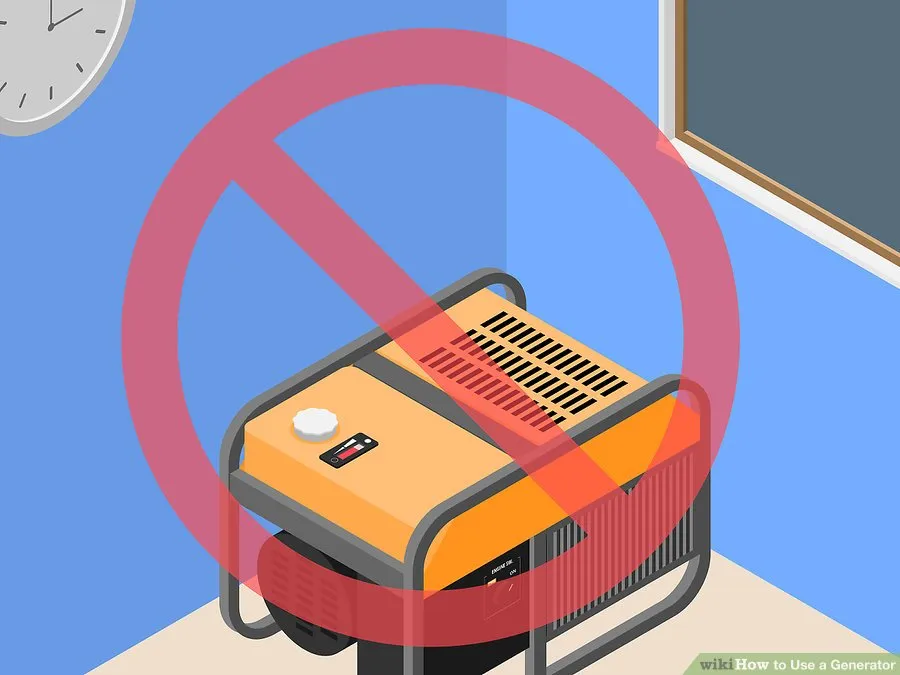
၂။ အိမ်တွင်းရှိ ခရီးဆောင်မီးစက်ကို ဘယ်တော့မှ မသုံးပါနှင့်။
သယ်ဆောင်ရလွယ်ကူသော ဂျင်နရေတာများသည် သေစေတတ်သော အခိုးအငွေ့များနှင့် ကာဗွန်မိုနောက်ဆိုဒ်ကို ထုတ်လုပ်နိုင်သည်။ ၎င်းတို့သည် အလုံပိတ် သို့မဟုတ် တစ်စိတ်တစ်ပိုင်း လေဝင်လေထွက်ရှိသော နေရာများတွင် ပိတ်မိနေသောအခါ ၎င်းတို့သည် ကြီးထွားလာပြီး ဖျားနာခြင်းနှင့် သေဆုံးသည်အထိ ဖြစ်စေနိုင်သည်။ အလုံပိတ်နေရာများတွင် သင့်အိမ်အတွင်းရှိ အခန်းများသာမက ကားဂိုဒေါင်၊ မြေအောက်ခန်း၊ တွားသွားသည့်နေရာ စသည်တို့လည်း ပါဝင်နိုင်သည်။ ကာဗွန်မိုနောက်ဆိုဒ်သည် အနံ့ကင်းပြီး အရောင်မရှိသောကြောင့် မီးခိုးငွေ့များကို မမြင်ရ သို့မဟုတ် အနံ့မခံပါက အိမ်တွင်းရှိ ခရီးဆောင်မီးစက်ကို အသုံးပြုပါက အန္တရာယ်ရှိနိုင်သည်။
- ဂျင်နရေတာအသုံးပြုသည့်အခါ မူးဝေခြင်း၊ ဖျားနာခြင်း သို့မဟုတ် အားနည်းခြင်းတို့ ခံစားရပါက ချက်ချင်းထွက်သွားပြီး လေကောင်းလေသန့်ကို ရှာဖွေပါ။
- မီးခိုးငွေ့များသည် သင့်အိမ်ထဲသို့ ဝင်ရောက်နိုင်သောကြောင့် သင့်မီးစက်ကို ဖွင့်ထားသော ပြတင်းပေါက်များ သို့မဟုတ် တံခါးများမှ အနည်းဆုံး ပေ 20 အကွာတွင် ထားပါ။
- သင့်အိမ်တွင် သယ်ဆောင်ရလွယ်ကူသော၊ ဘက်ထရီဖြင့်လည်ပတ်သော ကာဗွန်မိုနောက်ဆိုဒ် detectors များကို တပ်ဆင်နိုင်ပါသည်။ ဤအရာများသည် မီးခိုး သို့မဟုတ် မီးအချက်ပေးသံကဲ့သို့ အလုပ်လုပ်ကြပြီး အချိန်မရွေးရှိရန် စိတ်ကူးကောင်းဖြစ်သော်လည်း အထူးသဖြင့် သင်မီးစက်ကို အသုံးပြုနေချိန်ဖြစ်သည်။ ၎င်းတို့သည် အလုပ်လုပ်နေပြီး လတ်ဆတ်သော ဘက်ထရီများ ရှိနေကြောင်း သေချာစေရန် ၎င်းတို့ကို ပုံမှန်စစ်ဆေးပါ။
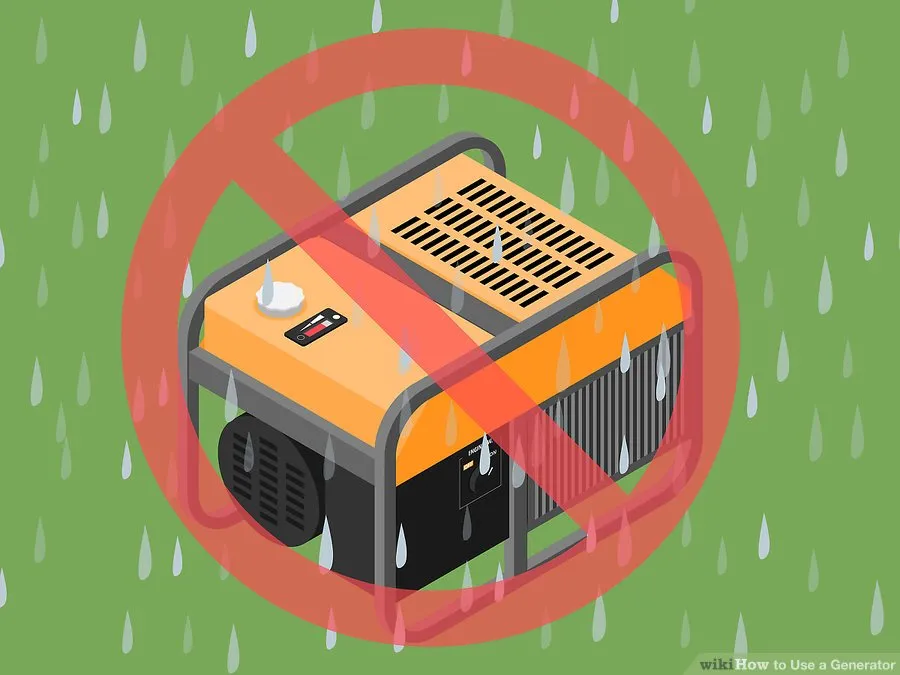
၃။ မိုးရွာသော သို့မဟုတ် စိုစွတ်သောအခြေအနေများတွင် မီးစက်ကို ဘယ်တော့မှ မလည်ပတ်ပါ။
ဂျင်နရေတာများသည် လျှပ်စစ်ဓာတ်အားထုတ်လုပ်ပေးပြီး လျှပ်စစ်နှင့်ရေသည် သေစေနိုင်သောပေါင်းစပ်မှုကို ဖြစ်စေသည်။ သင့်ဂျင်နရေတာအား ခြောက်သွေ့ပြီး အဆင့်ရှိသော မျက်နှာပြင်ပေါ်တွင် သတ်မှတ်ပါ။ ခေါင်မိုး သို့မဟုတ် အခြားဖုံးလွှမ်းထားသော ဧရိယာအောက်တွင် ထားရှိခြင်းသည် အစိုဓာတ်မှ ကာကွယ်နိုင်သော်လည်း ဧရိယာသည် ဘက်ပေါင်းစုံတွင် ပွင့်နေပြီး လေဝင်လေထွက်ကောင်းရပါမည်။
- စိုစွတ်သောလက်ဖြင့် မီးစက်ကို ဘယ်တော့မှ မထိပါနှင့်။
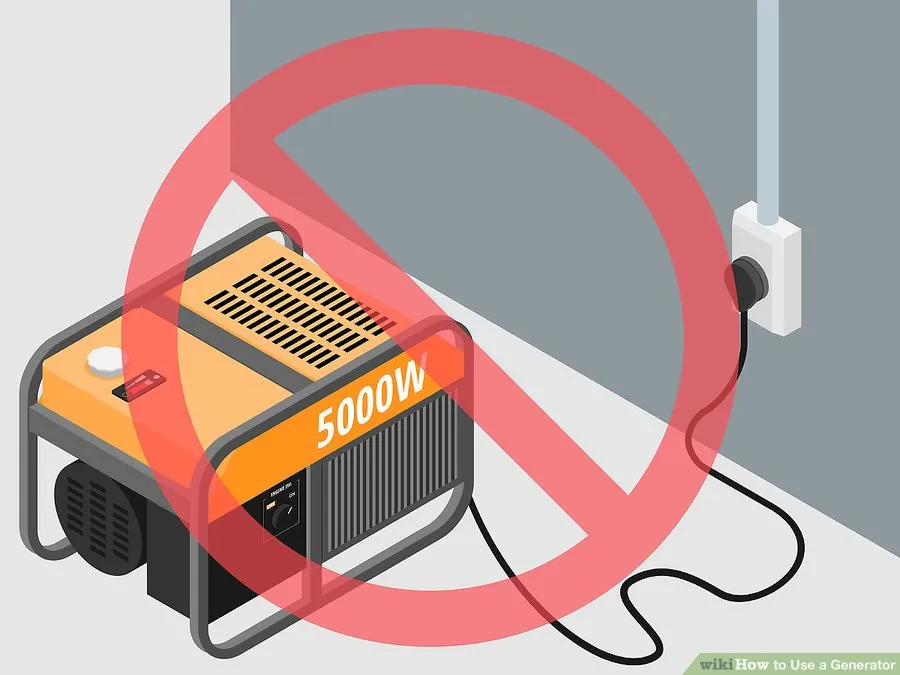
၄။ ခရီးဆောင်မီးစက်ကို နံရံပလပ်ပေါက်ထဲသို့ တိုက်ရိုက်မထည့်ပါနှင့်။
၎င်းသည် လျှပ်စစ်ဓာတ်အားလိုင်းသို့ ပြန်လည်ပတ်သောကြောင့် “backfeeding,” ဟုခေါ်သော အလွန်အန္တရာယ်များသော လုပ်ငန်းစဉ်ဖြစ်သည်။ ပြတ်တောက်နေစဉ်အတွင်း စနစ်တစ်ခုကို ပြုပြင်ရန် ကြိုးစားနေသည့် လျှပ်စစ်လုပ်သားများနှင့် သင့်အိမ်တို့ကို ထိခိုက်စေနိုင်သည်။
- သင့်အိမ်တွင် အရန်ပါဝါကို တိုက်ရိုက်ချိတ်ဆက်လိုပါက၊ သင့်တွင် လိုင်စင်ရ လျှပ်စစ်ပညာရှင်တစ်ဦး ပါဝါလွှဲပြောင်းခလုတ်နှင့် စာရေးကိရိယာ မီးစက်ကို တပ်ဆင်ရပါမည်။
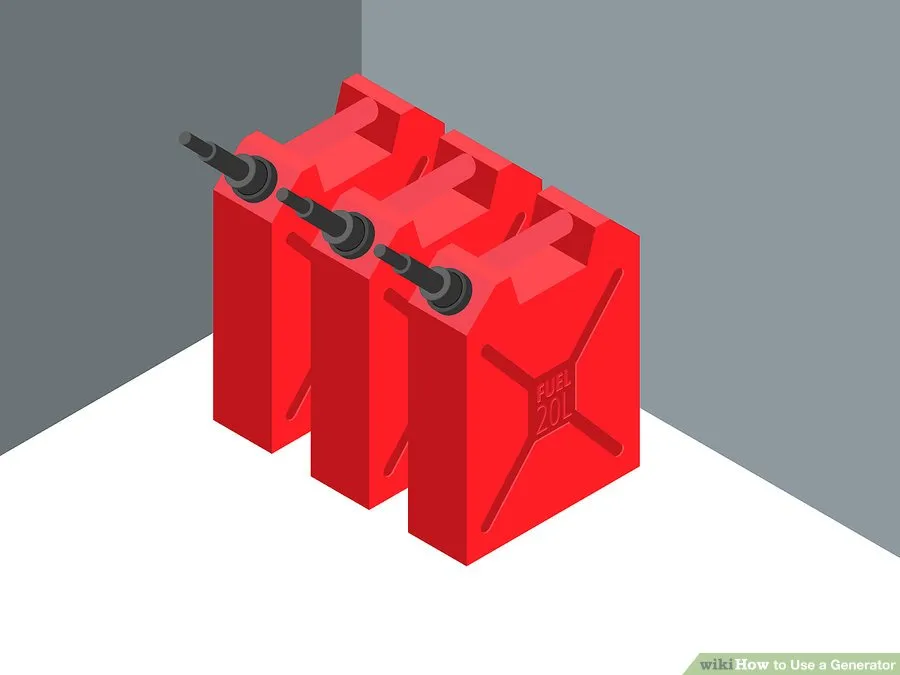
၅။ ဂျင်နရေတာ၏ လောင်စာဆီ မှန်ကန်စွာ သိမ်းဆည်းပါ။
အတည်ပြုထားသော လောင်စာဆီကွန်တိန်နာများကိုသာ အသုံးပြုပြီး ထုတ်လုပ်သူ၏ ညွှန်ကြားချက်များအတိုင်း လောင်စာဆီ သိမ်းဆည်းပါ။ အများအားဖြင့်၊ ၎င်းသည် သင့်အိမ်နှင့်ဝေးသော အေးမြခြောက်သွေ့သောနေရာတွင် မီးလောင်လွယ်သောပစ္စည်းနှင့် အခြားလောင်စာအရင်းအမြစ်များကို ဆိုလိုသည်။
